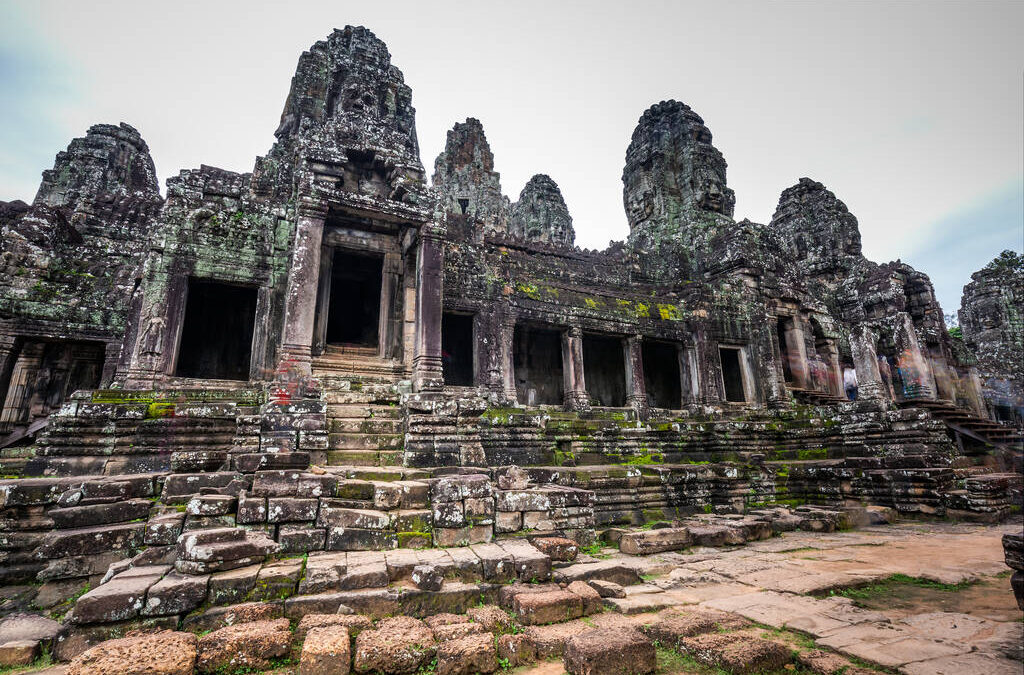You'll find five distinct artistic styles that revolutionized Khmer temple architecture: sacred geometry that mapped cosmic alignments, the evolution from early Indian-influenced designs to classical innovations, masterful material changes from brick to intricately carved sandstone, symbolic religious elements featuring divine interpretations, and Indian architectural traditions adapted into unique Khmer forms. These styles transformed simple structures into awe-inspiring monuments that still hold countless architectural secrets waiting to be uncovered!
Key Takeaways
- Temple-mountain style featuring pyramidal structures with multiple tiers representing Mount Meru and celestial realms.
- Mandala-based layouts incorporating sacred geometry with concentric galleries radiating from a central shrine.
- Intricate bas-relief carvings depicting religious narratives, mythological scenes, and daily life across temple walls.
- Evolution from brick architecture with stucco ornamentation to sandstone construction enabling detailed sculptural elements.
- Fusion of Indian architectural principles with local innovations, including distinctive five-tower configurations and decorative colonettes.
The Sacred Geometry of Khmer Temple Design
When you investigate the sacred geometry of Khmer temples, you'll uncover an incredible fusion of mathematical precision and spiritual symbolism!
These masterful architects weren't just building structures – they were creating cosmic maps that connected Earth to the heavens.
You can spot sacred ratios throughout temples like Angkor Wat, where every measurement and angle aligns with Hindu cosmology.
The temple's genius lies in its mandala layout, which transforms geometric patterns into a three-dimensional model of the universe.
Isn't it amazing how they achieved such precise cosmic alignments without modern tools?
The architects used Vedic mathematical principles to guarantee each tower, terrace, and gallery perfectly reflected their understanding of the cosmos.
Every diagonal line and cruciform terrace you see works together to create a unified design that's both mathematically perfect and spiritually powerful!
Evolution From Pre-Angkorian to Classical Styles
While Indian architectural influences initially shaped early Khmer temples, you'll see a fascinating transformation as these designs evolved into something distinctly spectacular!
You can trace this evolution through amazing temple innovations, starting with the rounded colonettes of Sambor Prei Kuk in the 7th century to the grand architectural changes of the Classical period.
You'll notice how the Khmer style really came into its own during these architectural changes. They began experimenting with square and octagonal colonettes during the Kulen period, and by the time they reached the Classical Angkorian age – WOW! – you're looking at masterpieces like Angkor Wat with its intricate carvings and concentric layouts.
What started as simple brick towers transformed into massive temple-mountains that'd make your jaw drop, complete with moats and walls symbolizing Mount Meru!
Material Mastery in Temple Construction
As you investigate the architectural genius of Khmer temples, you'll find they weren't just masters of design – they were absolute wizards with their building materials!
You can trace their remarkable evolution from early brick temples to magnificent sandstone monuments. The earliest builders started with brick durability in mind, coating structures like Preah Ko with decorative stucco since brick wasn't great for carving.
But here's where it gets clever – they uncovered sandstone usage was a game-changer! This tougher material let them create those incredibly detailed carvings you'll see today.
They didn't stop there – they mixed in laterite for foundations and used wood for internal structures. Talk about smart building! They even skipped using mortar, instead fitting stones together so precisely that many temples are still standing after centuries.
Symbolic Elements and Religious Motifs
The symbolic power of Khmer temples reveals an incredible spiritual universe in stone! You'll find sacred symbolism woven into every architectural element, from the soaring towers that represent Mt. Meru's peaks to the expansive moats symbolizing cosmic oceans.
These magnificent structures aren't just buildings – they're divine representations of the universe itself!
When you investigate a Khmer temple, you'll uncover these mind-blowing symbolic elements:
- Five majestic towers aligned with celestial bodies
- Intricate bas-reliefs telling epic Hindu stories
- Mystical makaras and dancing apsaras adorning walls
- Concentric galleries leading you on a voyage to enlightenment
You're not just walking through an ancient building – you're experiencing a three-dimensional mandala that connects Earth to the heavens.
It's architecture that literally transforms space into sacred geometry!
Indian Influences on Khmer Architectural Identity
Beginning in the 5th century AD, Indian architectural traditions fundamentally shaped the magnificent temples of the Khmer Empire. Through vibrant cultural exchange, you'll find Indian design principles beautifully woven into Cambodia's iconic structures – but don't think they're just copies! The Khmer builders created something distinctly their own.
| Indian Element | Khmer Adaptation |
|---|---|
| Mandala Layout | Modified for local terrain |
| Mount Meru concept | Steeper pyramidal forms |
| Rock-cut techniques | Free-standing structures |
| Sanskrit inscriptions | Khmer language enhancements |
| Hindu iconography | Local artistic style |
This architectural synthesis is most visible in temples like Angkor Wat, where you'll uncover traditional Indian cosmic symbolism merged with uniquely Khmer engineering solutions. The result? A breathtaking blend that perfectly captures the spirit of Southeast Asian innovation while honoring its Indian roots!
Conclusion
You've just investigated the remarkable artistry that makes Khmer temples architectural marvels! From their precise sacred geometry to the evolution of styles across centuries, these structures aren't just buildings – they're masterpieces of engineering and spirituality. Whether you're admiring the intricate carvings or studying the Indian-influenced design elements, you'll find that Khmer temples represent one of humanity's greatest achievements in religious architecture.



